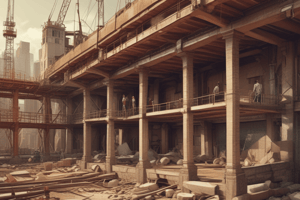Podcast
Questions and Answers
What is the main factor that affects the properties of materials?
What is the main factor that affects the properties of materials?
- Micro-structure
- Chemical composition (correct)
- Macro-structure
- Mineral composition (correct)
What happens to the strength, hardness, and toughness of carbon steel as carbon content increases?
What happens to the strength, hardness, and toughness of carbon steel as carbon content increases?
- They increase (correct)
- They remain constant
- They decrease
- They become zero
Why was stainless steel invented?
Why was stainless steel invented?
- To change the color of carbon steel
- To make carbon steel more resistant to rust (correct)
- To increase the strength of carbon steel
- To reduce the weight of carbon steel
What is the term for the structure of materials that can be identified with a magnifying glass or naked eyes?
What is the term for the structure of materials that can be identified with a magnifying glass or naked eyes?
What is the term for the chemical constituents of a material?
What is the term for the chemical constituents of a material?
What is the main factor that affects the properties of natural stone?
What is the main factor that affects the properties of natural stone?
What level of structure is above millimeter?
What level of structure is above millimeter?
What are the key factors related to the properties of materials?
What are the key factors related to the properties of materials?
What is the charge of the nucleus in an atom?
What is the charge of the nucleus in an atom?
What is the primary reason for atomic bonding?
What is the primary reason for atomic bonding?
What type of bond involves the transfer of an electron?
What type of bond involves the transfer of an electron?
What is a characteristic of ionic bonds?
What is a characteristic of ionic bonds?
What type of bond is commonly found in organic molecules?
What type of bond is commonly found in organic molecules?
What is the 'sea of electrons' model used to describe?
What is the 'sea of electrons' model used to describe?
What is a characteristic of metal materials?
What is a characteristic of metal materials?
What is the result of the electrostatic attraction between the nucleus and electrons?
What is the result of the electrostatic attraction between the nucleus and electrons?
What is the minimum scale that must be considered in the engineering level?
What is the minimum scale that must be considered in the engineering level?
What is isotropic material?
What is isotropic material?
What is studied in the meso-structure level?
What is studied in the meso-structure level?
What is the linear dimension of the representative cell for concrete?
What is the linear dimension of the representative cell for concrete?
What is the microstructure level?
What is the microstructure level?
What is the size of a wood cell wall thickness?
What is the size of a wood cell wall thickness?
What is anisotropic material?
What is anisotropic material?
What is the length of a brick in the meso-structure level?
What is the length of a brick in the meso-structure level?
Flashcards are hidden until you start studying
Study Notes
Materials Composition and Structure
- The composition of materials includes chemical composition and mineral composition, which are key factors for the properties of materials.
- Chemical composition refers to the chemical constituents, and various chemical compositions result in different properties.
- For example, the increase of carbon content in carbon steel changes its strength, hardness, and toughness.
- Mineral composition is the key factor for the properties of some building materials, such as natural stone, inorganic gel, and cement.
Structure of Materials
- The structure of materials can be divided into macro-structure, meso-structure, and micro-structure, which are key factors related to the properties of materials.
- Macro-structure refers to the thick structure above millimeter that can be identified with a magnifying glass or naked eyes, and is considered at the engineering level.
- Macro-structure is normally taken as continuous and homogeneous, and average properties are assumed throughout the whole volume of the material body.
- The minimum scale that must be considered is governed by the size of the representative cell, which varies from 10^-3 m for metals to 0.1 m for concrete and 1 m for masonry.
Meso-structure
- Meso-structure refers to the micro-level structure that can be observed by optical microscope, and is also known as sub-microstructure.
- This level is a step up in size from the molecular level, and the material is considered as a composite of different phases that interact to realize the behavior of the total material.
- The size, shape, and interface of grains and particles, and the size, shape, and distribution of pores and micro-cracks are mainly studied in this structure.
Microstructure
- Microstructure refers to the atomic and molecular structures of materials that can be studied by electron microscopy, X-ray diffractometer, and other means.
- Atoms, the building block of elements, consist of a nucleus surrounded by a cloud of orbiting electrons.
- The bonding of atoms is essential to form materials, and there are three types of bonds: ionic bond, covalent bond, and metallic bond.
Atomic Bonds
- Ionic bond involves a transfer of an electron, resulting in a high strength, hardness, and melting point, but with a volatile and medium density.
- Covalent bond involves the sharing of electrons between two atoms, resulting in a strong bonding force, high strength, hardness, and melting point, and high density.
- Metallic bond involves sharing electrons, resulting in a volatile strength and hardness, high density, and good thermal and electrical conductivity.
Studying That Suits You
Use AI to generate personalized quizzes and flashcards to suit your learning preferences.




